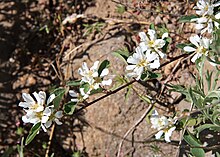This article includes a list of general references, but it lacks sufficient corresponding inline citations. (March 2023) |
Amelanchier utahensis, the Utah serviceberry, is a shrub or small tree native to western North America. This serviceberry grows in varied habitats, from scrubby open slopes to woodlands and forests.
| Utah serviceberry | |
|---|---|

| |
| Scientific classification | |
| Kingdom: | Plantae |
| Clade: | Tracheophytes |
| Clade: | Angiosperms |
| Clade: | Eudicots |
| Clade: | Rosids |
| Order: | Rosales |
| Family: | Rosaceae |
| Genus: | Amelanchier |
| Species: | A. utahensis
|
| Binomial name | |
| Amelanchier utahensis | |

| |
| Natural range of Amelanchier utahensis | |

Description
editAmelanchier utahensis is a spreading plant, reaching a maximum of five meters (16 feet) in height. It is deciduous, bearing rounded or spade-shaped often toothed green leaves and losing them at the end of the season. In April and May the shrub blooms in short inflorescences of white flowers, each with five widely spaced narrow petals. The fruits are pomes. The Utah serviceberry is browsed by desert bighorns, elk, and mule deer, as well as many birds and domesticated livestock.
Range
editThis section relies largely or entirely on a single source. (March 2023) |
For the Utah serviceberry, the core mountainous range is delimited by the Colorado–New Mexico–Wyoming Rocky Mountains[2] in the east, the Front ranges of Utah at the west, and the south in central Arizona-western New Mexico by the Mogollon Rim and White Mountains (Arizona) region[2] of east Arizona and New Mexico.
The rest of the range is centered on mountain ranges of the Great Basin, and extending west to the Sierra Nevada and chaparral and woodlands in California and as far south as extreme northern Baja California, and then in the north to southwestern Montana with Idaho.[2]
Uses
editThe Utah serviceberry is generally fire tolerant and sprouts from the root crown when damaged by fire.[3] The tree also has a high resistance to drought and high fruit abundance.[4] Additionally, it is not susceptible to frost.[5]
References
edit- ^ "NatureServe Explorer - Amelanchier utahensis". NatureServe Explorer Amelanchier utahensis. NatureServe. 2022-06-22. Retrieved 22 Jun 2022.
- ^ a b c Little Jr., Elbert L. (1976). "Map 17, Amelanchier utahensis". Atlas of United States Trees. Vol. 3 (Minor Western Hardwoods). US Government Printing Office. LCCN 79-653298. OCLC 4053799.
- ^ United States Forest Service. SPECIES: Amelanchier utahensis Retrieved on 20 Mar. 2023
- ^ USDA. Utah serviceberry - Characteristics. Retrieved on 20 Mar. 2023
- ^ Plants for a Future. Amelanchier utahensis - Koehne. "It is hardy to UK zone 3 and is not frost tender." Retrieved on 20 Mar. 2023
External links
edit- Ecology
- "Amelanchier utahensis". Plants for a Future.
- Jepson Manual Treatment = Amelanchier utahensis
- USDA Plants Profile: Amelanchier utahensis
- Amelanchier utahensis in the CalPhotos photo database, University of California, Berkeley
- Lady Bird Johnson database, w/ gallery
- Media related to Amelanchier utahensis at Wikimedia Commons
